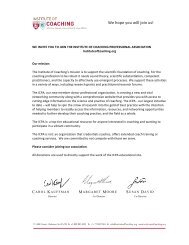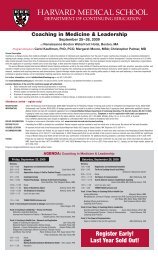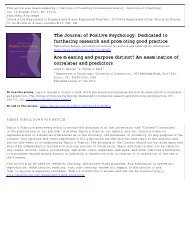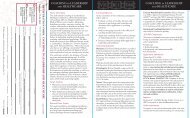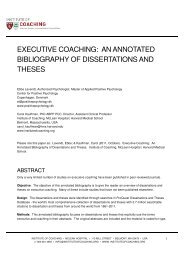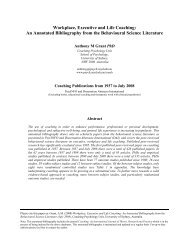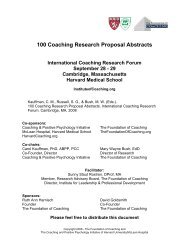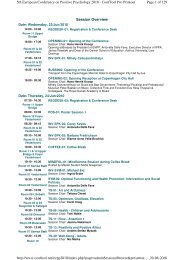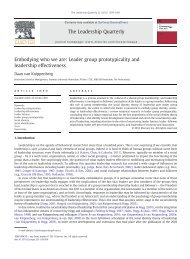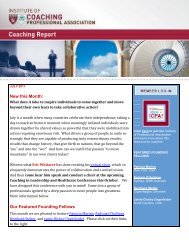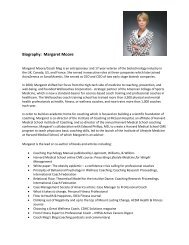Mindfulness in Leadership - Institute of Coaching
Mindfulness in Leadership - Institute of Coaching
Mindfulness in Leadership - Institute of Coaching
You also want an ePaper? Increase the reach of your titles
YUMPU automatically turns print PDFs into web optimized ePapers that Google loves.
<strong>M<strong>in</strong>dfulness</strong>, <strong>Leadership</strong> & the 4-Factor ModelGordon Spence PhD & Michael Cavanagh PhDCoach<strong>in</strong>g Psychology UnitUniversity <strong>of</strong> SydneyHarvard Coach<strong>in</strong>g Conference25 th September 2009
Acknowledgements• Dr Paul Atk<strong>in</strong>s & Dr Tony Grant (CIs)• ARC L<strong>in</strong>kage Project research team:– Kate Wisdom & Nickolas Yu (<strong>in</strong>dustry reps)– Sean O’Connor Connor, Helen Parker– Campbell MacBean, Andrew Wu, Vanessa Tripp, Anna Booy,Ingrid Studholme, & Doug MacKie (coaches)• Dr Jennifer Garvey-Berger• 231 participants (& count<strong>in</strong>g!)
Outl<strong>in</strong>e• Project overview• The 4-factor leadership model• <strong>M<strong>in</strong>dfulness</strong>, development & leadership• The role <strong>of</strong> coach<strong>in</strong>g• Case example• Conclusions
<strong>Leadership</strong> <strong>in</strong> High Stress Workplaces• Australian Research Council L<strong>in</strong>kage grant ($3.5mil)• 2 partner organisations (both Sydney-based)– Large law firm– Area health service (public)• 135 participants per organisation over 3 years (n=270)• Major challenge <strong>of</strong> both organisations is to ma<strong>in</strong>ta<strong>in</strong> a clientfac<strong>in</strong>g, engaged g and healthy workforce <strong>in</strong> high stresssituations• People attracted to organisations for pay, conditions,anticipated satisfaction but leave primary because <strong>of</strong> poorquality relations with others (usually the boss) (Gallup, 2006)
Study design• Randomised controlled study• 270 participants - 6 cohorts over three years• 3 conditions− Tra<strong>in</strong><strong>in</strong>g alone− Tra<strong>in</strong><strong>in</strong>g plus coach<strong>in</strong>g− Control• Measures pre, post, 12-month follow-up.5
Research goals1. Develop a method <strong>of</strong> enhanc<strong>in</strong>g engagement, retention,productivity it and satisfaction <strong>in</strong> high h stress workplaces2. Develop <strong>in</strong>struments that help us identify and developleaders and staff3. Assess the impact <strong>of</strong> coach<strong>in</strong>g over and above tra<strong>in</strong><strong>in</strong>g.6
The 4-factor modelPerspective-Tak<strong>in</strong>g Capacity (PTC)<strong>M<strong>in</strong>dfulness</strong>PurposePositivityCavanagh (2007)
Factor #1: Perspective-Tak<strong>in</strong>g Capacity• Critical meta-skill for leadership• Ability to understand, critically consider & <strong>in</strong>tegratemultiple compet<strong>in</strong>g perspectives to guide action(Cavanagh, Atk<strong>in</strong>s, Grant, Spence, 2006)• The ability to take a perspective that makes sense <strong>of</strong>what is go<strong>in</strong>g on <strong>in</strong> oneself, others & the system
Factor #2: <strong>M<strong>in</strong>dfulness</strong>• Emphasises importance <strong>of</strong> self-awareness to purposefulaction• The ability to observe the present momentdispassionately• Helps us see our own process & respond <strong>in</strong>tentionallyrather than reactively• Assists self-regulation by provid<strong>in</strong>g “moments <strong>of</strong> choice”
Factor #3: Purpose• Emphasises the directional/<strong>in</strong>spirational aspects <strong>of</strong>leadership• Good leaders are typically solution-focused; they willlearn from the past but will be oriented towards the future& build<strong>in</strong>g solutions• Leaders move towards goals they consider worthwhile,which means their behaviour is typically directed towardvaluable goals, committed & proactive
Factor #4: Positivity• Emphasises socio-emotional aspects <strong>of</strong> leadership• Ability to create expansive, emotional spacescharacterised by positive <strong>in</strong>terpersonal dynamics (e.g.hear<strong>in</strong>g & be<strong>in</strong>g heard, gett<strong>in</strong>g & giv<strong>in</strong>g quality feedback)that foster engagement, effort & growth• Involves embrac<strong>in</strong>g complexity & understand theemergent properties <strong>of</strong> complex systems
Types <strong>of</strong> development
Types <strong>of</strong> developmentHorizontal development• Involves expanded our exist<strong>in</strong>g skill sets• A quantitative change• E.g. Learn<strong>in</strong>g how to give feedback <strong>in</strong> a positive fashionVertical development• Involves expand<strong>in</strong>g understand<strong>in</strong>gs & perspectives• A qualitative change• E.g. Recognis<strong>in</strong>g the impact that good feedback has on the systemHorizontal development <strong>of</strong>ten supports vertical development. AsHorizontal development <strong>of</strong>ten supports vertical development. Aswe practice & master new skills we can beg<strong>in</strong> to see the limitations<strong>of</strong> exist<strong>in</strong>g understand<strong>in</strong>g & perspectives
Importance <strong>of</strong> <strong>M<strong>in</strong>dfulness</strong> to growth• Leaders cont<strong>in</strong>ually encounter situations that are laced withtension & paradox• Resolv<strong>in</strong>g these tensions requires a bigger perspective• Be<strong>in</strong>g m<strong>in</strong>dful helps us engage with the tension & not bereactive to it• Engag<strong>in</strong>g the tensions enables new perspectives to emerge• We can beg<strong>in</strong> to see th<strong>in</strong>gs previously missed, overlooked oravoided
Developmental challenges• Significant leadership challenge : Be<strong>in</strong>g able to <strong>in</strong>corporatemultiple perspectives (<strong>of</strong>ten compet<strong>in</strong>g) <strong>in</strong>to a bigger picture• In so do<strong>in</strong>g we transform them & open up new pathways tochange• This requires us to sit comfortably with the tension that arisesfrom this• Place <strong>of</strong> ambiguity, uncerta<strong>in</strong>ty and/or confusion• Highly aversive for some; can lead to attempts to avoidunpleasant streams <strong>of</strong> consciousness− “Experiential avoidance” (Hayes et al, 1999)
M<strong>in</strong>dful leaders “build bridges”• Different perspectives (or worldviews) can <strong>of</strong>ten seem likeimpossible chasms• When leaders engage others perspectives - so as tounderstand together - possibilities abound• This is how we build bridges!• Before we under-stand we don’tknow where to step!
The positive role <strong>of</strong> tension• Tension is critical <strong>in</strong> build<strong>in</strong>g bridges• Once we understand the tensions that we both see <strong>in</strong> thesituation, we can use these tensions as the structuralcomponents <strong>of</strong> the bridge• No tension, no bridge – it collapses!• Best approached through dialogueprocesses that allow people thespace & time to “th<strong>in</strong>k together”• When done well dialogue issynthetic, creative & respectful;when done badly it is additive,repetitive & polite
Non-judgmental awakeness• <strong>M<strong>in</strong>dfulness</strong> can help us be <strong>in</strong> the tension without be<strong>in</strong>greactive• As soon as we start suppress<strong>in</strong>g, controll<strong>in</strong>g, avoid<strong>in</strong>g orforeclos<strong>in</strong>g on the tensions we are tak<strong>in</strong>g up reactive positions& bridges start t collaps<strong>in</strong>g!• We need to get more comfortable with discomfort• <strong>M<strong>in</strong>dfulness</strong> is a state <strong>of</strong> non-judgmental awakenesscharacterized by openness & acceptance <strong>of</strong> moment-tomomentexperience• It is engagement with experience not attachment toexperiences (experiences are events, experience is a process)
What role does coach<strong>in</strong>g play <strong>in</strong> all this?Support<strong>in</strong>g vertical development• Coach<strong>in</strong>g can provide leaders with the scaffolded d supportneeded to develop bigger perspectives– a reflective “space” <strong>in</strong> which they can approach tensions safely todiscover new pathways forward• Notice our embeddedness <strong>in</strong> exist<strong>in</strong>g perspective & thelimitations that creates• Mak<strong>in</strong>g object that to which we are subject is the developmentalprocess (Kegan, 1994)
What role does coach<strong>in</strong>g play <strong>in</strong> all this?Support<strong>in</strong>g horizontal development• See<strong>in</strong>g th<strong>in</strong>gs differently requires do<strong>in</strong>g th<strong>in</strong>gs differently• Coach<strong>in</strong>g can help us develop the skill sets needed to supportthe enactment <strong>of</strong> our new perspectives− scaffolds current development & thickens the base for futuredevelopment• <strong>M<strong>in</strong>dfulness</strong> is an important skill set for change• It helps us notice how we th<strong>in</strong>k, feel & react to change,generate & rema<strong>in</strong> aware <strong>of</strong> our <strong>in</strong>tentions to change, & notic<strong>in</strong>gothers responses to change (<strong>in</strong> non-judgmental ways)
Case: “John”• Aviation <strong>in</strong>dustry - f<strong>in</strong>ancial controller, male, late 30s• Highly competent, perfectionistic, achievement oriented,pacesetter• Wanted to create high perform<strong>in</strong>g team, empower & developothers through coach<strong>in</strong>g, reduce stress• Dom<strong>in</strong>ant frame – bus<strong>in</strong>ess/commercial (i.e. sees leadershipthrough efficiency/pr<strong>of</strong>itability lens)• Subord<strong>in</strong>ate frame – <strong>in</strong>dividual id needs (i.e. see<strong>in</strong>g leadershipthrough lens <strong>of</strong> human nurturance & growth)• Tendency to go <strong>in</strong>to cocoon-like state; discourag<strong>in</strong>g toothers; fearful f <strong>of</strong> <strong>in</strong>terrupt<strong>in</strong>g ti him – less likely l to approach
Incorporation & transformationBigger, expandedperspective<strong>Leadership</strong> is aboutcreat<strong>in</strong>g value for allstakeholdersNow there is a horizontal taskto thickened the base & makethis perspective real <strong>in</strong> theworld through the use <strong>of</strong>appropriate communicationskills, etc.Perspective ABus<strong>in</strong>ess framePerspective BIndividual needsframe
Summary & conclusions• <strong>Leadership</strong> is about perspective & practice− PTC− <strong>M<strong>in</strong>dfulness</strong>− Purpose− Positivity• Both horizontal & vertical development needed• <strong>M<strong>in</strong>dfulness</strong> helps us <strong>in</strong> both tasks
<strong>M<strong>in</strong>dfulness</strong>, <strong>Leadership</strong> & the 4-Factor ModelThank you for listen<strong>in</strong>g.Questions?gordons@psych.usyd.edu.auHarvard Coach<strong>in</strong>g Conference25 th September 2009



